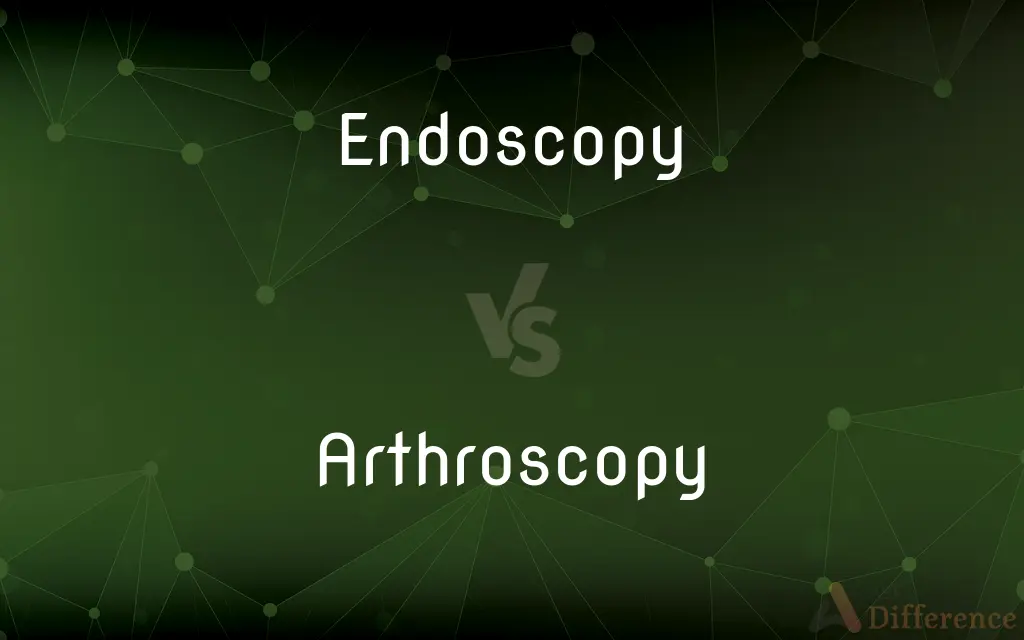Endoscopy vs. Arthroscopy — What's the Difference?
By Maham Liaqat & Fiza Rafique — Updated on March 17, 2024
Endoscopy is a medical procedure to examine the interior of the body using an endoscope, while arthroscopy specifically examines and treats joints with a smaller, specialized endoscope.

Difference Between Endoscopy and Arthroscopy
Table of Contents
ADVERTISEMENT
Key Differences
Endoscopy involves the use of an endoscope, a flexible tube with a light and camera, to view the internal structures of the body. This procedure can be used to investigate various systems within the body, such as the gastrointestinal tract, respiratory system, and more. On the other hand, arthroscopy is a type of endoscopy focused specifically on diagnosing and treating conditions within joints, utilizing a smaller instrument known as an arthroscope.
While endoscopy can be performed on many parts of the body and is often used for diagnostic purposes, such as identifying ulcers, cancers, or infections, arthroscopy is primarily used within orthopedics. It is often employed to address issues in joints like the knee, shoulder, elbow, and ankle, allowing for both diagnosis and surgical intervention, such as repairing torn tissue or removing debris.
Endoscopy procedures are diverse, including gastroscopy (esophagus, stomach, and small intestine), colonoscopy (colon and rectum), and bronchoscopy (lungs). Arthroscopy, however, is more specialized, focusing solely on joint health and often used to treat sports injuries or degenerative joint diseases.
The recovery time and risks associated with endoscopy vary depending on the specific procedure and the area of the body being examined. Arthroscopy, being minimally invasive and usually performed on an outpatient basis, typically allows for quicker recovery times and fewer complications compared to open joint surgery.
Both endoscopy and arthroscopy are valuable diagnostic and therapeutic tools in modern medicine, offering less invasive options for examining and treating internal conditions. They provide high-definition images of the body's interior, aiding in accurate diagnoses and targeted treatments.
ADVERTISEMENT
Comparison Chart
Purpose
To examine and diagnose conditions within various internal organs and cavities
Specifically to diagnose and treat joint issues
Instrument
Endoscope: a flexible tube with a light and camera
Arthroscope: a smaller, specialized endoscope for joints
Application Areas
Gastrointestinal tract, respiratory system, etc.
Joints like the knee, shoulder, elbow, and ankle
Common Procedures
Gastroscopy, colonoscopy, bronchoscopy
Surgical interventions in joints, like repair of torn ligaments
Nature
Mostly diagnostic, though some therapeutic interventions are possible
Both diagnostic and surgical, particularly in orthopedics
Recovery Time
Varies by procedure and body part
Generally quicker, as it's minimally invasive
Compare with Definitions
Endoscopy
Allows for visualization of internal body structures.
The doctor performed an endoscopy to inspect the patient's stomach lining.
Arthroscopy
Concentrates on diagnosing and treating joint problems.
Arthroscopy was used to examine the damage within the knee joint.
Endoscopy
Used across various medical fields for diagnosis.
An endoscopy revealed the cause of her persistent cough.
Arthroscopy
Commonly employed in orthopedic surgery.
The orthopedic surgeon performed an arthroscopy to repair a torn meniscus.
Endoscopy
Primarily used for identifying conditions.
Endoscopy helped diagnose the early stages of gastrointestinal cancer.
Arthroscopy
Includes procedures like ligament repair.
The arthroscopy allowed for precise repair of the torn ligament.
Endoscopy
Encompasses a range of procedures like colonoscopy.
A colonoscopy is a type of endoscopy focusing on the large intestine.
Arthroscopy
Offers a less invasive alternative to open surgery.
Arthroscopy led to a quicker recovery compared to traditional surgery.
Endoscopy
Can involve treatments like polyp removal.
The endoscopy enabled the removal of polyps from the colon.
Arthroscopy
Frequently used for sports-related joint injuries.
The athlete underwent arthroscopy for a shoulder injury.
Endoscopy
An endoscopy (looking inside) is a procedure used in medicine to look inside the body. The endoscopy procedure uses an endoscope to examine the interior of a hollow organ or cavity of the body.
Arthroscopy
Arthroscopy (also called arthroscopic or keyhole surgery) is a minimally invasive surgical procedure on a joint in which an examination and sometimes treatment of damage is performed using an arthroscope, an endoscope that is inserted into the joint through a small incision. Arthroscopic procedures can be performed during ACL reconstruction.
Endoscopy
A slender, tubular instrument, such as an arthroscope or laparoscope, that is inserted into a body cavity or part for the purpose of visual examination, diagnosis, or surgical treatment.
Arthroscopy
A surgical procedure in which an arthroscope is passed to the interior of a joint through a small incision for the purpose of visual examination, diagnosis, or treatment; arthroscopic surgery.
Endoscopy
(medicine) The examination of a bodily orifice, canal or organ using an endoscope.
Arthroscopy
The examination of the interior of a joint (such as the knee) using an arthroscope
Endoscopy
The art or process of examination or treatment by means of an endoscope.
Arthroscopy
A minimally invasive operation to repair a damaged joint; the surgeon examines the joint with an arthroscope while making repairs through a small incision
Endoscopy
Visual examination of the interior of a hollow body organ by use of an endoscope
Common Curiosities
Can arthroscopy be used to treat all joint problems?
While arthroscopy is versatile, not all joint issues are suitable for arthroscopic treatment; some may require open surgery or other interventions.
How long does it take to recover from an endoscopy?
Recovery from an endoscopy can vary, but many patients resume normal activities within a day, barring any major interventions during the procedure.
How do doctors decide between endoscopy and arthroscopy?
The choice depends on the area of the body being examined or treated; endoscopy is more general, while arthroscopy is specific to joints.
Is anesthesia required for endoscopy and arthroscopy?
Both procedures typically require some form of anesthesia, local or general, depending on the specific procedure and patient needs.
Are there risks associated with arthroscopy?
Like all surgical procedures, arthroscopy carries risks, such as infection or complications from anesthesia, but these are relatively low.
Can endoscopy procedures treat conditions, or are they just for diagnosis?
While primarily diagnostic, some endoscopy procedures can also treat conditions, such as removing polyps during a colonoscopy.
What kind of doctors perform arthroscopy?
Orthopedic surgeons typically perform arthroscopy, specializing in the musculoskeletal system.
Is endoscopy safe for children?
Yes, endoscopy can be safely performed on children, with considerations for pediatric anesthesia and the child's specific health needs.
How is the recovery process for arthroscopy?
Recovery from arthroscopy is usually quicker and less painful than from open surgery, with many patients returning to normal activities within a few weeks.
How effective is arthroscopy in diagnosing joint problems?
Arthroscopy provides high-definition images of the inside of the joint, making it a highly effective tool for diagnosing joint issues.
Can endoscopy be used to examine the heart?
While endoscopy typically refers to gastrointestinal and respiratory examinations, similar techniques, like echocardiography, use scopes to examine the heart.
How long does an arthroscopy procedure take?
Arthroscopy can take from 30 minutes to over an hour, depending on the complexity of the condition being treated.
Are there alternatives to arthroscopy for joint examination?
Non-invasive imaging methods like MRI and CT scans can also be used to examine joints, though they may not offer the same level of detail or allow for immediate treatment.
Share Your Discovery

Previous Comparison
Image vs. Illustration
Next Comparison
Peninsula vs. SpitAuthor Spotlight
Written by
Maham LiaqatCo-written by
Fiza RafiqueFiza Rafique is a skilled content writer at AskDifference.com, where she meticulously refines and enhances written pieces. Drawing from her vast editorial expertise, Fiza ensures clarity, accuracy, and precision in every article. Passionate about language, she continually seeks to elevate the quality of content for readers worldwide.














































